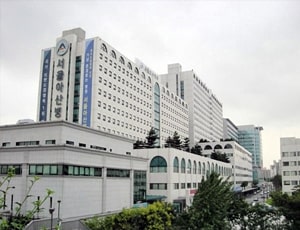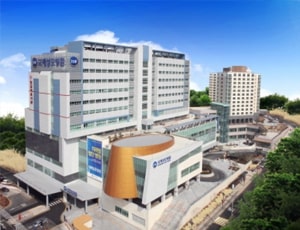The average cost of Microdiscectomy in Seoul approximately starts from USD 13000
Treatment cost

Asan Medical Centre located in Seoul, South Korea is accredited by ISO. Also listed below are some of the most prominent infrastructural details:


International St. Mary's Hospital located in Seoul, South Korea is accredited by JCI. Also listed below are some of the most prominent infrastructural details:
Microdiscectomy is also known as microdecompression or cervical microdiscectomy. It is one of the most commonly performed spine surgery procedures.
Microdiscectomy or cervical microdiscectomy is preferred for patients with a lumbar herniated disc. The main goal of a discectomy is to relieve the pressure on a spinal nerve root by removing the material causing the pain. Traditionally, this purpose was solved by an open technique called lumbar discectomy surgery, which involves making a large incision to cut some of the back muscles, leading to a slow and painful recovery. Nowadays, an advanced form of surgery called microdiscectomy can achieve the same goal that too with the help of a small incision and fewer injury to back muscles. As a result, the recovery takes less time and is less painful. A special microscope is used in microdiscectomy to view the disc and nerves. The larger view allows the surgeon to make a smaller incision, causing less damage to the surrounding tissues.
Sciatica is a condition caused by compression of the spinal nerve, which generally results in chronic pain in the legs of the patients. This compression of the spinal nerve is frequently the result of a herniated lumbar disc. As a herniagrows, the damaged tissue extends into the spinal column and pushes on the nerves. This condition causes the nerves to send pain signals to the brain and the brain interprets the pain source to be coming from the legs.
Most commonly, sciatica heals naturally or with the help of medication in a few weeks. But, if sciatica lasts more than 12 weeks after taking oral medicines, patients may benefit from discectomy. Discectomy is also used for the treatment of spondylosis and lumbar spinal stenosis. While spondylosis occurs due to degenerative osteoarthritis of the vertebrae, lumbar spinal stenosis occurs due to narrowing of the spinal canal leading to nerve compression. The latter may also warrant the need for a spinal stenosis surgery.
Lumbar discectomy surgery is typically performed for rehabilitation of a herniated disc. The same thing is done during microdiscectomy, but with the help of a special microscope. During this procedure, a small part of the bone over the nerve root and disc material under the nerve root is taken out, which finally result in relieving pressure on the spinal nerve column. The microdiscectomy treatment starts by giving general anesthesia to the patient. The patient will be unconscious during the entire surgery and is not able to feel anything. Preoperative intravenous antibiotics are given before the surgery.
The procedure is performed with the patient lying face down, generally using a special operating table with special paddings. The surgical region is cleansed with a cleaning solution. A one-to two-centimeter incision is made directly over the area of the herniated disc. Special retractors and a lighted operating microscope are used to allow the surgeon to see the region of the spine. It helps in minimizing or avoid cutting of the adjacent muscles and tissues.
Before removing a herniated disc, a small piece of bone called lamina is removed from the affected vertebra. This is called a laminotomy, a procedure which allows the surgeon to fully visualize the herniated disc. Small scissor-like tools and grasping instruments are used to remove the protruding disc material. Lastly, the incision area is washed out with sterile water containing antibiotics and the deep fascial layer and subcutaneous layers are closed with a few sutures. The skin is fixed up using special surgical glue and does not require bandages.
The microdiscectomy recovery time is much less than any other invasive procedure. Typically, the patient can expect to leave the hospital within 24 hours of the surgery. Patients may be advised to meet a physical therapist before leaving the hospital. The therapist will instruct the patient on how to reduce twisting and bending of the back. The therapist may advise some exercises to improve the strength and flexibility of the muscles around the spine.
Patients are advised not to drive, sit for a prolonged period, lift anything heavy and bend over immediately after the surgery. The patient is able to resume normal activities after two weeks, but they are advised to avoid lifting heavy objects for at least four weeks after the surgery. Full recovery after microdiscectomy procedure takes at least four to six weeks.
Microdiscectomy is a faster pain relief option than nonsurgical treatment in case of a lumbar herniated disc, but it is not significantly clear that whether surgery makes a difference in what treatment may be needed later on.
Some post-microdiscectomy researchers determined that people who have had microdiscectomy have reported similar improvements as other treatments after one year of surgery. Although it is a less invasive procedure in comparison to other treatment such as spinal fusion, microdiscectomy also involves certain risks just like any other surgery.
Some of the common microdiscectomy risks are:
Ask your healthcare adviser for the best multiple options and choose the one that meets your expectations
In Seoul, the average starting cost for Microdiscectomy is $13000. Only some of the best and certified hospitals in Seoul perform Microdiscectomyation for international patients.
The Microdiscectomy package cost in Seoul varies from one hospital to another and may offer different benefits. The Microdiscectomy package cost usually includes all the expenses related to pre and post surgery expenses of the patient. The Microdiscectomy cost in Seoul includes the cost of anesthesia, medicines, hospitalization and the surgeon's fee. A prolonged hospital stay due to delayed recovery, new diagnosis and complications after surgery may increase the cost of Microdiscectomy in Seoul.
There are many hospitals across the country that offer Microdiscectomy to international patients. For quick reference, the following are some of the leading hospitals for Microdiscectomy in Seoul:
After Microdiscectomy in Seoul, the patient is supposed to stay in guest house for another 13 days. This period is important to conduct all the follow-up tests to ensure that the surgery was successful and the patient can go back to the home country.
Apart from the cost of Microdiscectomy, the patient is also required to pay additionally for daily meals and guest house accommodation. These are the charges for daily meals and accommodation outside the hospital. The per day cost in this case may range from 40 USD.
The patient is supposed to stay at the hospital for about 1 Days after Microdiscectomy surgery for monitoring and care. The patient is subjected to several biochemistry and radiological scans to see that everything is okay and the recovery is on track. After making sure that patient is clinically stable, discharge is planned.
There are around 2 Hospitals hospitals in Seoul that offer Microdiscectomy to international patients. These hospitals have proper infrastructure for the treatment of patients who require Microdiscectomy. Apart from good services, the hospitals are known to follow all standard and legal guidelines as dictated by the local medical affairs body or organization.
Some of the most sought after doctors for Microdiscectomy in Seoul are:
One of the most popular destinations for medical tourism in the world, Seoul, the capital of South Korea attracts around 60% of the patients traveling to the country for quality care. More than 2.76 million International patients travel to South Korea on average. This can be attributed to high-quality medical services, economical healthcare services, and affordable packages that combine both treatment and relaxation. The number of healthcare organizations in Seoul tally up to 21,507. Out of these, 14 are advanced hospitals that provide a range of healthcare services. The high success rate of cancer treatment, plastic surgery, and organ transplants attract the majority of foreign patients to Seoul. Hundreds and thousands of patients from abroad travel to Seoul for cosmetic and plastic surgery. The largest proportion of medical tourists belonged to China and the United States. The top hospitals in Seoul have well-trained medical staff along with coordinators that help international patients availing treatments without any issues.
Seoul has a wide network of internationally accredited hospitals that are using cutting-edge medical technology to treat patients. Some of the top hospitals in Seoul are:
The doctors in Seoul obtained their medical education and training from some of the most reputed medical institutions around the world. Some of the top doctors in Seoul are:
Seoul is a major healthcare center and is well connected to the major cities in the globe via air. You can reach the city by international flights. If you are planning to travel, then we can assist you in making the journey hassle-free.